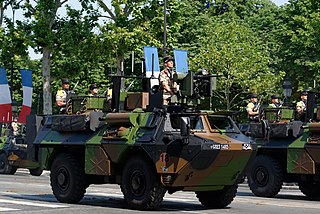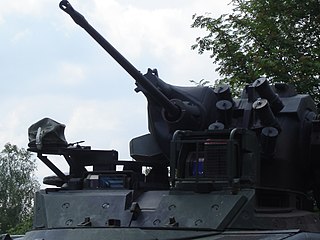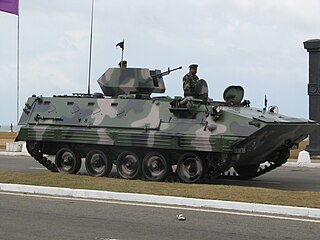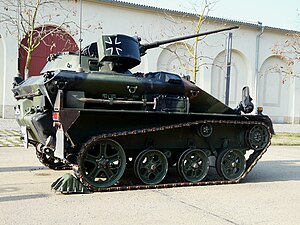
An armoured fighting vehicle or armored fighting vehicle (AFV) is an armed combat vehicle protected by armour, generally combining operational mobility with offensive and defensive capabilities. AFVs can be wheeled or tracked. Examples of AFVs are tanks, armoured cars, assault guns, self-propelled artilleries, infantry fighting vehicles (IFV), and armoured personnel carriers (APC).

A tankette is a tracked armoured fighting vehicle that resembles a small tank, roughly the size of a car. It is mainly intended for light infantry support and scouting. Colloquially it may also simply mean a small tank.

The Boxer is a multirole armoured fighting vehicle designed by an international consortium to accomplish a number of operations through the use of installable mission modules. The governments participating in the Boxer programme have changed as the programme has developed. The Boxer vehicle is produced by the ARTEC GmbH industrial group, and the programme is being managed by OCCAR. ARTEC GmbH is based in Munich; its parent companies are Krauss-Maffei Wegmann GmbH and Rheinmetall Military Vehicles GmbH on the German side, and Rheinmetall Defence Nederland B.V. for the Netherlands. Overall, Rheinmetall has a 64% stake in the joint venture.

The Véhicule de l'Avant Blindé or VAB is a French armoured personnel carrier and support vehicle designed and manufactured by Renault Trucks Defense. It entered French service in 1979 and around 5,000 were produced for the French Army as well as for export. It has seen combat in various conflicts in Africa, Asia as well as Europe and has also been exported to more than 15 countries.

The Schützenpanzer Marder 1 is a tracked German infantry fighting vehicle designed for use with the West German Panzergrenadiere units, mechanized infantry specialized for IFV combat. It has been operated by the German Army as the main Panzergrenadiere IFV from 1970s through to the present day. Developed as part of the rebuilding of West Germany's armoured fighting vehicle industry, the Marder has proven to be a successful and solid infantry fighting vehicle design.

The FV432 is the armoured personnel carrier variant in the British Army's FV430 series of armoured fighting vehicles. Since its introduction in the 1960s, it has been the most common variant, being used for transporting infantry on the battlefield. At its peak in the 1980s, almost 2,500 vehicles were in use.

The TPz Fuchs from Transportpanzer Fuchs is a German armoured personnel carrier originally developed by Daimler-Benz, and manufactured and further developed by the now Rheinmetall MAN Military Vehicles (RMMV). Fuchs was the second wheeled armoured vehicle to enter service with the Bundeswehr. It can be used for tasks including troop transport, engineer transport, bomb disposal, Nuclear, Biological and Chemical reconnaissance and electronic warfare. RMMV and its predecessors manufactured 1,236 Fuchs 1, mostly for the German Army.

The Rheinmetall Mk 20 Rh-202 is a 20 mm caliber autocannon designed and produced by Rheinmetall. It fires the 20×139mm ammunition originally developed for the Hispano-Suiza HS.820.

The Fennek, named after the fennec, or LGS Fennek, with LGS being short for Leichter Gepanzerter Spähwagen in German, is a four-wheeled armed reconnaissance vehicle produced by the German company Krauss-Maffei Wegmann and Dutch Defence Vehicle Systems. The Turkish company FNSS Defence Systems acquired the right for licence production in 2004. It was developed for both the German Army and Royal Netherlands Army to replace their current vehicles.
A huge number of M113 Armored Personnel Carrier variants have been created, ranging from infantry carriers to nuclear missile carriers. The M113 armored personnel carrier has become one of the most prolific armored vehicles of the second half of the 20th century, and continues to serve with armies around the world in many roles.
The Henschel Wehrtechnik TH-200, TH-400, and TH-800 are a family of wheeled armoured fighting vehicles by Thyssen-Henschel. Their development was loosely related to the Spähpanzer Luchs.
List of abbreviations, acronyms and initials related to military subjects such as modern armour, artillery, infantry, and weapons, along with their definitions.

The Norinco Type 89 tracked armoured fighting vehicle is a Chinese armoured personnel carrier. It was developed from the earlier export market Type 85 AFV vehicle. It entered service in the late 1990s and was first shown publicly in 1999. There are approximately 1,000 in service. It has the industrial index of WZ534 and although it was mainly developed for the PLA, there is also an export version YW534.

Jäger Regiment 1 was an air assault infantry regiment of the German Army. While it comes from the old German tradition of Jäger, it was a relatively recently formed air assault formation, established in 2006. The regiment was part of Airmobile Operations Division, and became subordinate to 21st Armoured Brigade on 19 December 2012. Soldiers of this unit were deployed to the combat zone by helicopters which are supposed to provide fire support as well. Until creation of the Jäger Regiment 1, the Bundeswehr had no air assault capability. The regiment was disbanded and partly replaced by a new battalion in 2015.
FNSS Savunma Sistemleri A.Ş. is a Turkish defense manufacturer founded in 1988. It is owned 51% by Nurol Holding of Turkey and 49% by British–American firm BAE Systems Inc., and operates facilities located in Gölbaşı, Ankara.
Ordnance Factory Medak (OFMK), previously called Ordnance Factory Project Medak (OFPM) while in its development stage, is a factory owned by Armoured Vehicles Nigam Limited, a company that manufactures armoured vehicles and was one of the 41 Indian ordnance factories under the erstwhile Ordnance Factories Board of the Ministry of Defence, controlled by Government of India.

The Type 08 is a family of eight-wheeled amphibious, modular armored vehicle developed by Norinco for infantry fire support, battlefield logistics, and quick reaction operations. Developed in the early 2000s, the modern Chinese vehicle family were produced for more than 6000 hulls and widely deployed by the People's Liberation Army Ground Force and People's Liberation Army Marine Corps.

The Lynx is a German armoured fighting vehicle developed by Rheinmetall Landsysteme. The Lynx, configured as a KF31 infantry fighting vehicle (IFV), was unveiled at the Eurosatory defence exhibition on 14 June 2016. The KF41 variant was unveiled at the Eurosatory defence exhibition on 12 June 2018. According to Rheinmetall, the Lynx family of tracked armoured vehicles is at the forefront of a new trend in IFV design toward armoured vehicles with lower unit and through-life costs and reduced complexity. One of the key principles of the Lynx concept is the integration of proven sub-systems with a high technology readiness level to reduce development time, cost and technical risk.























